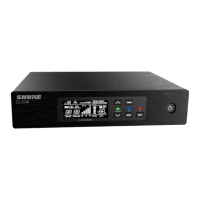
Do you have a question about the Shure QLX-D Wireless System and is the answer not in the manual?
| System Type | Digital wireless system |
|---|---|
| Audio Frequency Response | 20 Hz - 20 kHz |
| Dynamic Range | 120 dB |
| Operating Range | 100 m (line of sight) |
| Total Harmonic Distortion | < 0.5% |
| Receiver Outputs | XLR, 1/4" |
| Networking | Ethernet |
| Encryption | 256-bit AES |
| Transmitter Type | Handheld, bodypack |
| Signal-to-Noise Ratio | 120 dB |
| Connector Type | XLR, 1/4" |
Covers essential safety instructions for operating the apparatus, including handling, environment, and maintenance.
Provides critical warnings regarding battery handling, charging, disposal, and potential hazards like explosion or toxic material release.
Details ministerial license requirements for equipment operation and user responsibility for compliance.
Explains FCC rules for Class B digital devices and measures to correct harmful interference.
Describes the QLX-D Wireless System's digital audio clarity, design, and core functionalities for live sound.
Lists prominent features including 24-bit digital audio, wide frequency range, dynamic range, networking, and encryption.
Identifies the basic components included in the QLX-D system package.
Details additional components that create systems for specific performance needs, like handheld and bodypack models.
Step-by-step instructions for connecting power, antennas, and audio outputs to the receiver.
Guides users on how to use the receiver's scan function to find the optimal frequency.
Instructions for accessing the battery compartment and installing batteries (AA or SB900).
Details the process of using IR sync to automatically tune the transmitter to the receiver.
Provides guidance on testing audio levels and adjusting gain for optimal performance.
Identifies and describes the controls, indicators, and connectors on the receiver's front and back panels.
Details the parts of the transmitter, including power, display, IR window, and battery compartment.
Instructions for installing batteries and setting the correct battery type for accurate runtime reporting.
Describes the information shown on the transmitter display, including battery status, group/channel, encryption, and RF power.
Explains how to navigate the transmitter menu, select options, and edit parameters.
Details the various indicators on the receiver display, such as group, channel, RF signal, audio level, and battery status.
Guides users through navigating the receiver's main and advanced menus for setup and configuration.
Provides approximate transmitter runtimes for Alkaline, NiMH, and Lithium Primary batteries based on battery indicator levels.
Details the Shure SB900 rechargeable battery option, including charging times and charger models.
Offers essential tips for the proper care and storage of Shure rechargeable batteries to ensure performance and longevity.
Explains the simplest method to create an audio channel using receiver scan and transmitter IR sync.
Details how to manually set the receiver and transmitter to the same group and channel number.
Describes an alternative method to set the transmitter and receiver to a specific frequency manually.
Guides on adjusting the system's overall signal level using receiver gain controls for optimal audio.
Explains how to select between Lo and Hi RF power settings to determine transmitter range.
Provides guidance on how to properly clip or attach the bodypack transmitter for best performance.
Details how to configure TV channel spacing to match regional bandwidth usage and display local channels.
Describes how to lock or unlock receiver and transmitter controls to prevent accidental changes.
Explains how to enable AES-256 encryption for secure audio transmission and how to remove it.
Details how to link two transmitters to a receiver and match audio levels using Mic Offset.
Covers creating, deleting, and loading custom groups of channels and frequencies.
Guides on connecting to a network, automatic IP addressing, and general configuration tips.
Provides solutions for common networking issues, including connectivity and device detection.
Details manual configuration of IP and subnet addresses using the receiver menu or Wireless Workbench.
Explains how to use Network Scan for automatic frequency assignment across networked receivers.
Describes how to connect the receiver to external control systems like AMX or Crestron via Ethernet.
Information on QLX-D receiver compatibility with the Shure AXT600 Spectrum Manager.
Covers managing settings like RF/audio meters, transmitter settings, frequency, encryption, gain, and locks.
Details viewing the receiver in WWB6 inventory and using the Hardware Identify function.
Guides on downloading firmware using Shure Update Utility and applying it to receivers and transmitters.
Details QLX-D/ULX-D system compatibility and provides a table of error codes and their solutions.
Addresses issues like no sound, distortion, faint sound, range problems, and noise bursts.
Covers troubleshooting for control lock issues, power, gain, cables, firmware mismatch, RF interference, and overload.
Instructions for single/dual rackmount assembly and securing the AC power cord.
Diagrams and descriptions of receiver output connectors and the TA4M connector.
Details RF carrier range, working range, sensitivity, audio response, dynamic range, and operating temperatures.
Provides specifications for dimensions, weight, housing, power, RF input, audio output, and networking for the QLXD4 receiver.
Lists specifications for the QLXD1 transmitter, including mic offset, battery, dimensions, and audio/RF output.
Lists specifications for the QLXD2 transmitter, including mic offset, battery, dimensions, and audio/RF output.
Details the available frequency bands and corresponding transmitter RF power output levels.
Lists available accessories for batteries, chargers, and mounting hardware.
Details optional cables, antennas, antenna splitters, and line amplifiers.

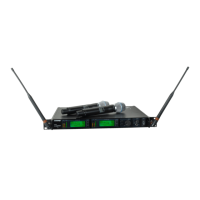
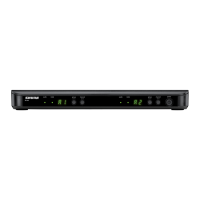
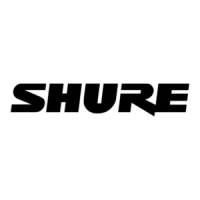
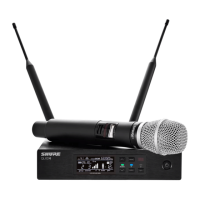

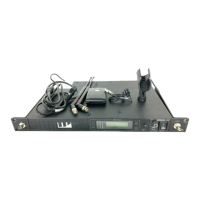
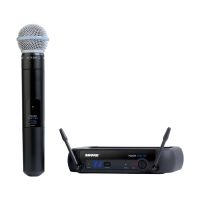
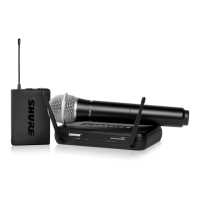



